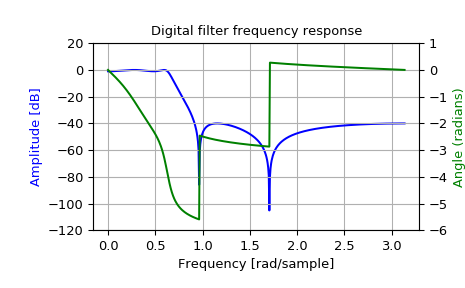scipy.signal.iirdesign¶
-
scipy.signal.iirdesign(wp, ws, gpass, gstop, analog=False, ftype='ellip', output='ba', fs=None)[source]¶ Complete IIR digital and analog filter design.
Given passband and stopband frequencies and gains, construct an analog or digital IIR filter of minimum order for a given basic type. Return the output in numerator, denominator (‘ba’), pole-zero (‘zpk’) or second order sections (‘sos’) form.
- Parameters
- wp, wsfloat
Passband and stopband edge frequencies. For digital filters, these are in the same units as fs. By default, fs is 2 half-cycles/sample, so these are normalized from 0 to 1, where 1 is the Nyquist frequency. For example:
Lowpass: wp = 0.2, ws = 0.3
Highpass: wp = 0.3, ws = 0.2
Bandpass: wp = [0.2, 0.5], ws = [0.1, 0.6]
Bandstop: wp = [0.1, 0.6], ws = [0.2, 0.5]
For analog filters, wp and ws are angular frequencies (e.g. rad/s).
- gpassfloat
The maximum loss in the passband (dB).
- gstopfloat
The minimum attenuation in the stopband (dB).
- analogbool, optional
When True, return an analog filter, otherwise a digital filter is returned.
- ftypestr, optional
The type of IIR filter to design:
Butterworth : ‘butter’
Chebyshev I : ‘cheby1’
Chebyshev II : ‘cheby2’
Cauer/elliptic: ‘ellip’
Bessel/Thomson: ‘bessel’
- output{‘ba’, ‘zpk’, ‘sos’}, optional
Type of output: numerator/denominator (‘ba’), pole-zero (‘zpk’), or second-order sections (‘sos’). Default is ‘ba’.
- fsfloat, optional
The sampling frequency of the digital system.
New in version 1.2.0.
- Returns
- b, andarray, ndarray
Numerator (b) and denominator (a) polynomials of the IIR filter. Only returned if
output='ba'.- z, p, kndarray, ndarray, float
Zeros, poles, and system gain of the IIR filter transfer function. Only returned if
output='zpk'.- sosndarray
Second-order sections representation of the IIR filter. Only returned if
output=='sos'.
See also
butterFilter design using order and critical points
buttordFind order and critical points from passband and stopband spec
iirfilterGeneral filter design using order and critical frequencies
Notes
The
'sos'output parameter was added in 0.16.0.Examples
>>> from scipy import signal >>> import matplotlib.pyplot as plt >>> import matplotlib.ticker
>>> wp = 0.2 >>> ws = 0.3 >>> gpass = 1 >>> gstop = 40
>>> system = signal.iirdesign(wp, ws, gpass, gstop) >>> w, h = signal.freqz(*system)
>>> fig, ax1 = plt.subplots() >>> ax1.set_title('Digital filter frequency response') >>> ax1.plot(w, 20 * np.log10(abs(h)), 'b') >>> ax1.set_ylabel('Amplitude [dB]', color='b') >>> ax1.set_xlabel('Frequency [rad/sample]') >>> ax1.grid() >>> ax1.set_ylim([-120, 20]) >>> ax2 = ax1.twinx() >>> angles = np.unwrap(np.angle(h)) >>> ax2.plot(w, angles, 'g') >>> ax2.set_ylabel('Angle (radians)', color='g') >>> ax2.grid() >>> ax2.axis('tight') >>> ax2.set_ylim([-6, 1]) >>> nticks = 8 >>> ax1.yaxis.set_major_locator(matplotlib.ticker.LinearLocator(nticks)) >>> ax2.yaxis.set_major_locator(matplotlib.ticker.LinearLocator(nticks))

